

Move your mouse over the picture to see the names of the various craters.
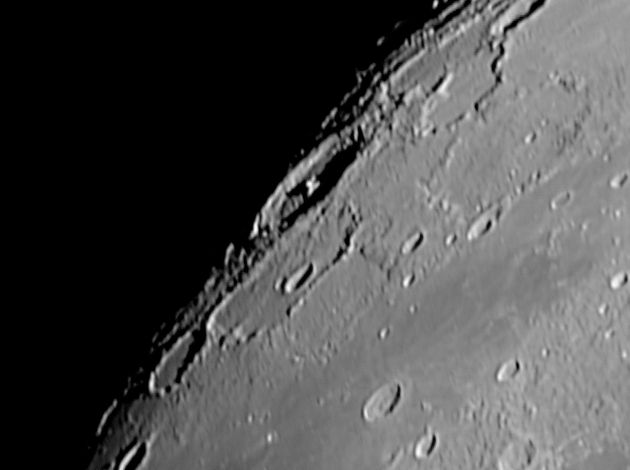
Pythagoras is a large crater (133 Km in diameter and 4800 metres deep) which formed between 1,000 and 3,000 million years ago. It is shown much better here than in my earlier image because here the libration was much more favourable (2° 54' in latitude, -3° 23' in longitude). The lighting is also from the other direction so that here the edge is the terminator not the limb.
I have another picture showing Pythagoras on my Mare Frigoris page.
The scale markers are approximately 100 Km north and east and apply at Pythagoras.
The picture was taken when the Moon was 12.5 days old.
Date and Time: 11 May 2006 00:24 UT
Camera: ToUcam 740K
Telescope: LX200 at prime focus
Capture: K3CCDTools. High gamma, 1/50", 0% gain, 381 frames
Processing: Registax. 102 frames stacked, wavelets 1 = 10, 2 = 5, gamma 1.3, histogram 15-255
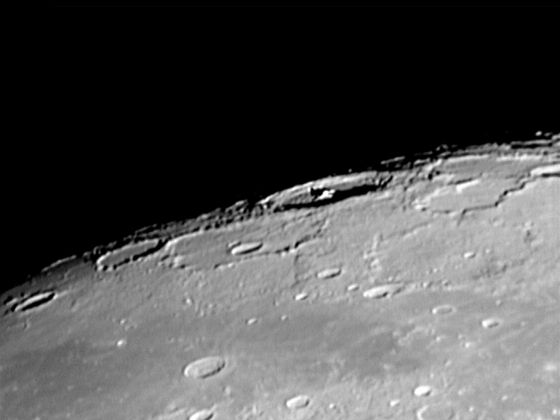
And here is Pythagoras imaged a day later, but the shadows in Pythagoras are very similar. The libration has almost compensated for the extra day. Compared to the image above, the Moon has been tilted some 2° northward (making Pythagoras looked more squashed), and over 9° to the west. The terminator moves about 12° in a lunar day, so almost ¾ of this has been removed by the libration. Hence the very similar shadows.
The picture was taken when the Moon was 13.5 days old.
Date and Time: 26 October 2004 21:56 UT
Camera: ToUcam 740K
Telescope: LX200 at prime focus
Capture: K3CCDTools. High gamma, 1/500", 0% gain
Processing: Registax. 97 frames stacked, wavelets 1-3 = 10
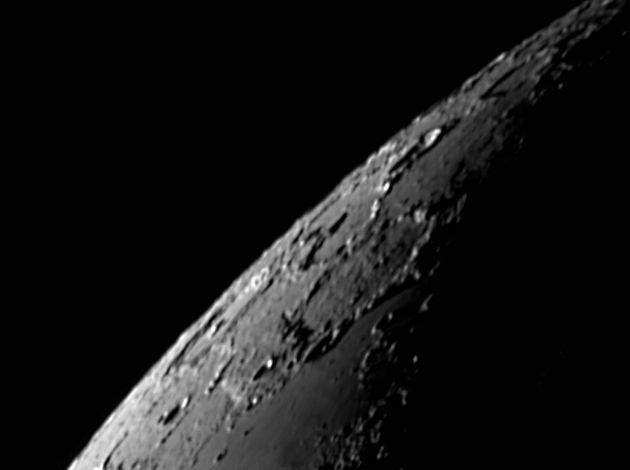
And here is the same area imaged much later in the lunar day and also at a much less favourable libration (-2° 32' in latitude, +5° 4' in longitude). The light is coming from the other direction, and the very rough floor of J. Herschel is clearly evident.
The scale markers are approximately 100 Km north and east and apply at Pythagoras.
The picture was taken on 17th October 2006, when the Moon was 25.0 days old.
Date and Time: 17 October 2006 04:17 UT
Camera: ToUcam 740K
Telescope: LX200 at prime focus
Capture: K3CCDTools. 50% gamma, 1/33", 36% gain
Processing: Registax. 4 alignment points, 311 frames stacked, wavelets 1 = 10, 2 = 5
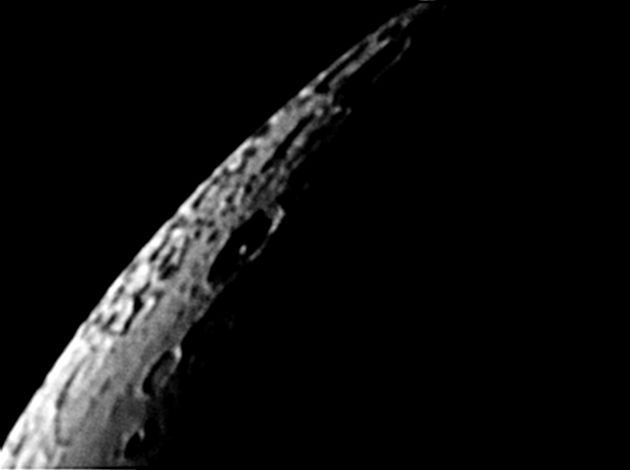
The same area imaged a day later but at a very favourable libration (6° 14' in latitude, -3° 16' in longitude). Pythagoras has almost moved out of view and the craters in the libration zone have come into view. The lighting is poor at this phase and the picture was taken only 20 minutes before sunrise and the Moon was only 14° above the horizon, so conditions were not ideal. The picture was taken using my ETX125 which has a shorter focal length than my LX200, hence the smaller scale.
The scale markers are approximately 100 Km north and east and apply at Pythagoras.
The picture was taken on 17th December 2006, when the Moon was 26.3 days old.
Date and Time: 17 December 2006 07:47 UT
Camera: Atik 1-HS
Telescope: ETX125 at prime focus and IR-pass filter
Capture: K3CCDTools. High gamma, 1/25", 67% gain
Processing: Registax. 333 frames stacked, wavelets 1-3 = 10, sigmoid gamma, histogram 50-220, Gaussian wavelets 1 = 0, 2 = 20.
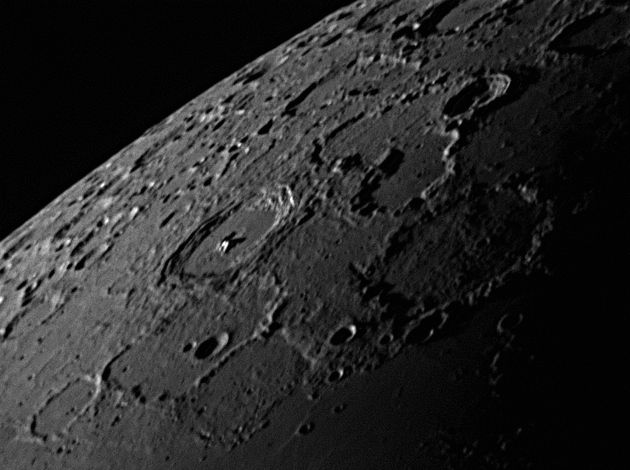
The same general area imaged two days earlier in the lunar cycle but at an even more favourable libration (6° 46' in latitude, -6° 16' in longitude) and with much better lighting. The picture was taken using my LX200 at prime focus.
The scale markers are approximately 100 Km north and east and apply at Pythagoras.
A picture of the whole of the north-western libration zone can be found here.
The picture was taken on 22nd October 2011, when the Moon was 24.3 days old.
Libration: latitude +6° 46', longitude -6° 16'
Solar inclination: -1.1°
Lunar Phase: 244.1°
Colongitude: 212.7°
Date and Time: 22 October 2011 05:13 UT
Camera: DMK 21AF04
Telescope: LX200 at prime focus and CLS filter
Capture: ICCapture. Gamma 10, 1/1000", gain 1023, 3358 frames
Processing: Registax. 7 alignment points, 100 frames per alignment point stacked, Gaussian wavelets Scheme 1, histogram 0-225.
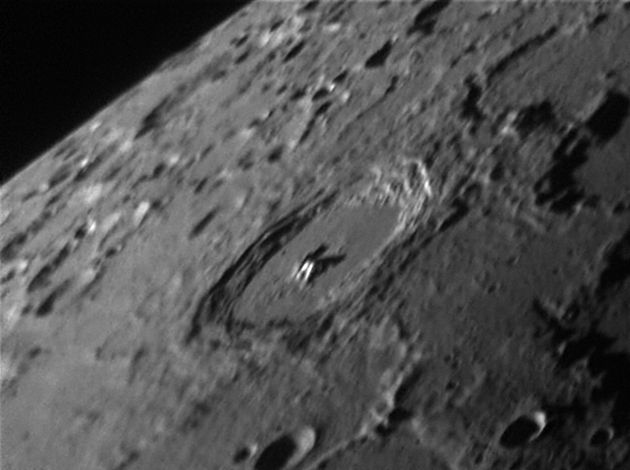
And here is a close-up picture of Pythagoras taken on the same morning using my LX200 with X2 adaptor. Particularly visible here are twin shadows of the central peaks. An overhead view from Lunar Orbiter shows that there is a group of three central mountains, the easterly two of which are just resolved in my picture. These give rise to the right-hand shadow. The third mountain is a ridge running roughly north-south and its shadow is the left-hand of the two shadows.
The picture was taken on 22nd October 2011, when the Moon was 24.3 days old.
Libration: latitude +6° 46', longitude -6° 16'
Solar inclination: -1.1°
Lunar Phase: 244.1°
Colongitude: 212.7°
Date and Time: 22 October 2011 05:10 UT
Camera: DMK 21AF04
Telescope: LX200 with X2 lens and CLS filter
Capture: ICCapture. Gamma 10, 1/367", gain 1023, 3378 frames
Processing: Registax. 10 alignment points, 100 frames per alignment point stacked, Gaussian wavelets Scheme 3, histogram 0-135.
Focus Magic 5,100.
Home Back to NW Quadrant